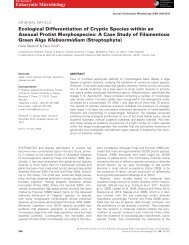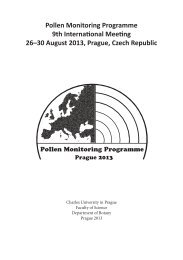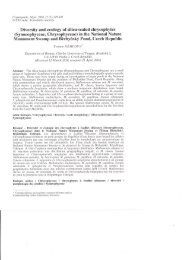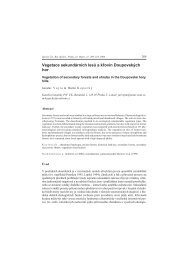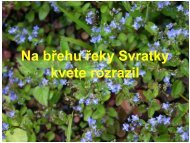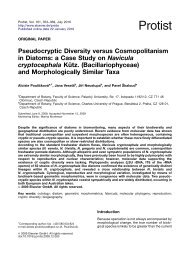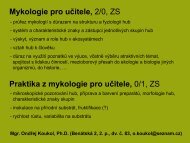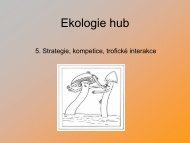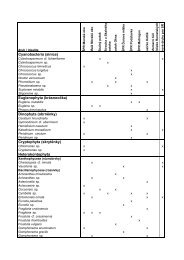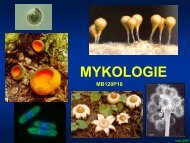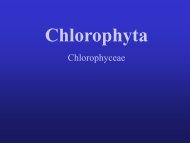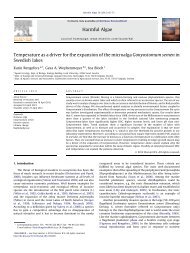Trebouxiophyceae, Chlorophyta - (S)FTP hesla na Botany
Trebouxiophyceae, Chlorophyta - (S)FTP hesla na Botany
Trebouxiophyceae, Chlorophyta - (S)FTP hesla na Botany
Create successful ePaper yourself
Turn your PDF publications into a flip-book with our unique Google optimized e-Paper software.
General introduction<br />
tio<strong>na</strong>l light or fluorescent microscopes. Moreover, three-dimensio<strong>na</strong>l objects displayed by<br />
CLSM can be virtually cut into several optical slices, which can be later used for computer<br />
a<strong>na</strong>lyses and shape reconstructions.<br />
Above mentioned characteristics thus facilitate and greatly improve studies of plant<br />
chloroplasts, e<strong>na</strong>bling their exami<strong>na</strong>tion directly inside living cells using autofluorescence of<br />
the chlorophyll. Van Spronsen et al. (1989) presented some of the first observations of plant<br />
tissue using CLSM. To achieve their excellent images, they had simply placed whole pieces<br />
of leaf tissue between coverslips and then performed the confocal observations. Recently,<br />
CLSM has been repeatedly applied for the exami<strong>na</strong>tion of chloroplast morphology and structural<br />
dy<strong>na</strong>mics in higher plants (see Hepler & Gunning 1998; Wildman et al. 2004). However,<br />
it has only rarely been used in the investigations of algal chloroplasts, so far. The essential<br />
paper dealing with the algal chloroplast autofluorescence was published by Gunning &<br />
Schwartz (1999). These authors examined heterogeneity of chlorophyll fluorescence in<br />
chloroplasts of selected green algae and revealed differences in chloroplast ultrastructure between<br />
<strong>Chlorophyta</strong> and Streptophyta. Afterwards, CLSM was further used to investigate<br />
chloroplast morphology in Eugle<strong>na</strong> geniculata (Zakrys et al. 2002), changes in the distribution<br />
of the fluorescence intensity within plastids of Eugle<strong>na</strong> gracilis exposed to manganese<br />
excess (Ferroni et al. 2004) and plastid division in several Mallomo<strong>na</strong>s species (Weatherill et<br />
al. 2007).<br />
Despite its contemporary sporadic use, confocal microscopy and subsequent threedimensio<strong>na</strong>l<br />
reconstructions can add useful information in studies of the phenotypic plasticity<br />
of algal chloroplasts and for detailed investigation of chloroplast ontogeny during cell cycle<br />
(Fig. 7). Therefore, CLSM represents an important tool to facilitate the morphological delimitation<br />
of particular species in taxonomic studies. Especially in green microalgae, the morphological<br />
investigation of often structurally complicated chloroplasts can be essential for the<br />
identification of even small morphological differences among particular species (Škaloud &<br />
Radochová 2004).<br />
Fig. 7. Three-dimensio<strong>na</strong>l reconstructions of chloroplast morphology in several algae, as observed by confocal laser<br />
scanning microscope (from left to right: Zygnema, Mougeotia, Cosmarium, Spirogyra (after Hepler & Gunning 1998).<br />
4



